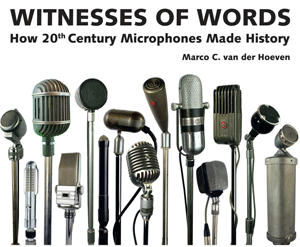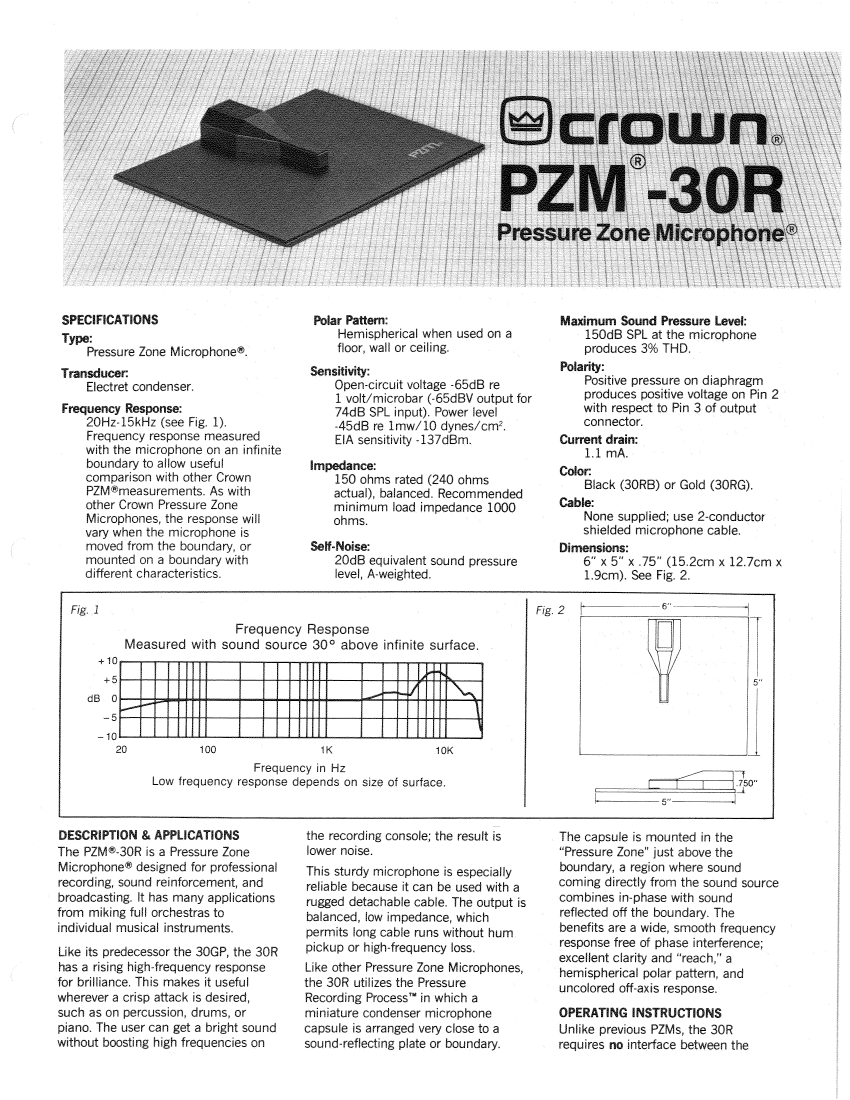|
Not one, but two microphones this time, they are closely related, yet very different.
The first is the PZM 30, a Presure Zone Microphone. It was invented by Ed Long and Ron Wickersham, after a discussion about recording techniques, during a training course for sound engineers, in San Francisco, in 1978.
The PZM recording principle is based on the fact that sound reaching a boundary (like a wall or floor) it is 6 dB louder than in the room (free field). And when an omni directional microphone is aimed at, and a few millimeters away from a boundary, it can record the sound without the reflections having an influence. Reflections usually produce a 'comb filter' effect during a 'normal' recording, where microphones are positioned in the room (free field). These various reflected frequencies influence the direct sound, amplifying some frequencies and attenuate others (the teeth of the 'comb' are the amplified frequencies, the space between them the attenuated ones).
The microphone was developed at Crown, an American manufacturer of PA amplifiers, which now also entered the microphone market.
In the PZM microphone design, a small electret microphone capsule is mounted a few millimeters above a metal plate, the boundary. The plate reflects the sound to the microphone. If the plate itself is mounted on a larger surface, such as on a floor or on a wall, lower frequencies can also be reproduced well. The result is a clear sound, the PZM system delivers 6dB more sound pressure, while the reflections are only amplified by 3 dB: a big difference!
The first Crown PZM microphones were produced in series around 1980, with the PZM 30 as the most important type.
For use away from the wall or floor, the PZMs could be mounted on larger wooden or perspex plates, although this could lead to visual problems. Crown loosely uses the 4-40 formula, an area of 4 square feet correctly reproduces sound down to 40 Hz.
The development did not stop, in 1985 the PCC 160 followed, a Phase Coherent Cardioid type; a small electret capsule with an highly directional recording pattern is mounted perpendicular to a metal boundary.
Again, the result is a microphone that is almost un- affected by comb filter effects, but since sound is recorded from one direction, the result is even more powerful: 6 dB more sensitive compared to the PZM. The sound can be adjusted with a switch on the bottom: low, flat or with low boost.
This PCC type proved superior for recording stage sound. With two or three such microphones at the front of the stage, a complete stage performance can be amplified. The capsule is protected by a sturdy metal cage, so it cannot be crushed.
PCCs are also great for amplifying pianos and concert grand pianos, mounted on the inside of the soundboard, or under the lid of the grand piano, and for kick drum, in the drum on a cushion or rug, facing the beater.
PPCs also deliver better sound if they are mounted on a larger surface. The larger the surface, the better the bass response. PCCs that are closer to the sound source than their own size (such as when used for kick drum) do not suffer low frequency loss.
Both types are real problem solvers in highly reverberant spaces, such as churches. They are also widely used for speakers; a PZM or PCC on a lectern provides excellent speech intelligibility. PZMs are also widely used for round table discussions, where the PZM lies in the middle or hangs from the ceiling above. PZMs can also often be found in police stations, where they are used inconspicuously for interrogations.
Both types are still made, after the takeover of Crown by AKG these are now badged as AKG, still with the same type numbers, now made in China.
Later versions of the PZM 30 also got a switch for a neutral sound or extra high tones.
Other manufacturers also made these types of microphones, but Crown's patents forced them to adapt their designs. Competing PZMs, such as by Neumann, DPA and Schoeps, have an upward-facing capsule mounted flush within a flat housing.
PCCs, such as the Shure Beta 91 and Sennheiser E 901, are more similar to the original, but these are often specifically intended for the kick drum and can therefore handle a higher sound pressure of approximately 150dB, the PCC 160 is more sensitive with a maximum of 120 dB, enough for most kick drums.
Making your own PCC is quite simple: a hyper cardioid condenser microphone lying flat on a flat surface gives the same result. Schoeps even has a round plate with clamp in its range to turn their condenser capsules into such a PCC.
These and many more types feature in my book Witnesses of Words. More information about that can be found at www.witnessesofwords.com

|
|
|
|
|
|
|
Top: the Crown PZM 30 RB, it should be all black, but someone exchanged the mic part with a 30 RG (gold coloured), side view and back of the PZM with the label
Below: sound of the 30 RB, PCC 160, and PCC 160 back with switch
Bottom: Crown drawing explaining PZMs and PCCs, Boundary application guide and PZM 30 RB sheet |
|
|
|
|
|
|
 |
|
|